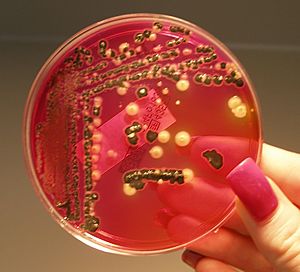Welton Taylor facts for kids
Quick facts for kids
Welton Ivan Taylor
|
|
|---|---|
| Born | November 12, 1919 |
| Died | November 1, 2012 (aged 92) Chicago, Illinois, U.S.
|
| Citizenship | United States |
| Education | University of Illinois at Urbana-Champaign |
| Known for | Salmonella test, XLD agar |
| Awards | National Inventors Hall of Fame, inducted 2016; naming of Enterobacter taylorae |
| Scientific career | |
| Fields | Microbiology |
Welton Ivan Taylor (born November 12, 1919 – died November 1, 2012) was an American microbiologist, inventor, and civil rights activist. He is famous for his work on germs that cause illness from food. He created important tests for Salmonella bacteria. He also invented the XLD agar (Xylose Lysine Deoxycholate agar), which helps find Salmonella and Shigella bacteria.
After getting his PhD from the University of Illinois at Urbana-Champaign, Taylor worked at a food company called Swift & Company. There, he developed a good test for salmonella in food. This led to his later research, mostly at Children's Memorial Hospital in Chicago. He focused on finding quick and accurate ways to detect specific germs in hospitals.
Taylor was also a strong supporter of civil rights throughout his life. He worked to make sure everyone had equal rights, no matter their race.
In 2016, Welton Taylor was honored by being added to the National Inventors Hall of Fame. Also, in 1985, a new type of bacteria was named Enterobacter taylorae after him and another scientist.
Contents
Early Life and Education

Welton Taylor was born in Birmingham, Alabama, on November 12, 1919. Soon after he was born, his family had to move. They moved to Chicago, then to Peoria, and finally back to the Bronzeville neighborhood in Chicago.
In Chicago, Taylor went to DuSable High School. He was a very good student and graduated in 1937 as the best student in his class.
Local African-American businessmen helped Taylor go to college. They were part of the Kappa Alpha Psi group and were impressed by his grades. Taylor went to the University of Illinois at Urbana-Champaign. He earned a bachelor's degree in bacteriology (the study of bacteria) in 1941. While at the university, he was also part of the Reserve Officers' Training Corps (ROTC).
Military Service and Continued Education
When World War II began, Taylor joined the U.S. Army. He served in the South Pacific. He was a pilot who helped direct artillery fire from the air. His unit was the 93rd Infantry Division. This unit was separate from white units at the time.
After the war, Taylor used the G.I. Bill to go back to the University of Illinois. He earned his master's degree in bacteriology in 1947. He then completed his PhD in 1948. For his PhD, he studied how a germ called Clostridium botulinum grew in cottage cheese.
Fighting for Equality
Throughout his life, Taylor faced unfair treatment because he was Black. This included his time in the army, which had unfair rules at the time. He wrote about these experiences in his memoirs.
As a civil rights activist, Taylor worked hard for racial equality. He worked with white veterans in Urbana-Champaign. Together, they tried to end unfair rules in restaurants, movie theaters, and public swimming pools. Taylor was also one of the first African Americans to move into Chicago's Chatham neighborhood. He became president of the Chatham Avalon Park Community Council.
Taylor married Jayne Rowena Kemp in 1945. They had two daughters, Karyn and Shelley. Welton and Jayne were married for many years until Jayne passed away in 2005.
Scientific Discoveries
In 1948, Taylor started teaching at the University of Illinois College of Medicine. He studied gas gangrene and tetanus. These were serious infections that soldiers often got from wounds. Taylor and his colleague Milan Novak found that penicillin could help prevent both diseases.
From 1954 to 1959, Taylor worked at the food company Swift & Company. When there was an outbreak of salmonella there, Taylor and his colleague John Silliker created an accurate test. This test could find salmonella in egg yolks. This testing method is still used today. In 1959, Taylor and Silliker also got a patent for a new way to destroy food germs using bacteriophages (viruses that infect bacteria).
In 1959, Taylor became the Microbiologist-in-Chief at Children's Memorial Hospital in Chicago. He received a special fellowship to study in Britain and France in 1961. He helped develop ways to prevent salmonella poisoning from imported meat.
When he returned to Children's Memorial Hospital in 1962, Taylor continued his work. He developed fast testing methods for other bacteria that cause food poisoning. These included Shigella (a common cause of diarrhea) and Enterobacteriaceae. He received several patents for his methods. These methods were used around the world to help keep processed food safe.
The XLD Agar
In 1965, Taylor developed the XLD agar. This is a special gel that helps scientists find Salmonella and Shigella bacteria. It can be used for samples from patients or from food. XLD agar is still a standard tool used in hospitals and labs today. It is especially good for finding Salmonella enterica.
In 1975, Taylor helped start the Journal of Clinical Microbiology. This journal publishes important research about germs. He also worked as an editor for the journal from 1975 to 1983.
Taylor also created a "Device for Use in the Identification of Microorganisms." This device had different sections with special gels. These gels allowed for quick and accurate identification of different bacteria in hospitals. The FDA in the U.S. approved this device. It was also approved in Canada and Europe to make sure food was free of bacteria. Taylor started a company called Micro-Palettes Inc. to sell these devices, but the company closed in 1988.
Awards and Recognition
Welton Taylor's inventions for testing food led to his induction into the National Inventors Hall of Fame in 2016. This is a great honor for inventors.
In 1985, scientists from the Center for Disease Control named a new type of bacteria Enterobacter taylorae. They named it after Welton Taylor and another British scientist named Joan Taylor. They honored Welton Taylor for his many contributions to understanding bacteria, especially for creating the XLD agar and finding Shigella and other germs.


